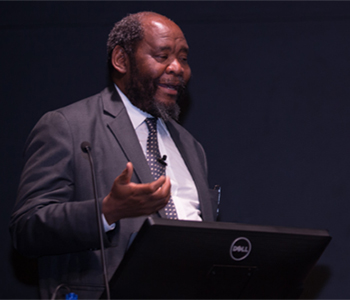
Pali Lehohla, outgoing Statistician-General speaking at the
Centennial celebration of Oliver Tambo.
Photo: Supplied
To celebrate Oliver Reginald Tambo’s centennial year, the Oliver and Adelaide Tambo Foundation, in partnership with the Rector and Vice-Chancellor of the University of the Free State (UFS), Prof Francis Petersen, and Absa Bank, hosted an interactive dialogue session, titled “Educating Africa’s Future” on 26 September 2017 on the Bloemfontein Campus.
Students encouraged to take charge of their future
The event opened up dialogue on some of the current burning issues that affect students in South Africa, societal challenges such as poverty and crime, and how leaders such as Tambo envisaged a free Africa. Prof Petersen highlighted the role that universities played in developing society, in creating leaders and crafting the path to transformation. Other speakers included Pali Lehohla, outgoing Statistician-General, Linda Vilakazi, CEO of the Oliver and Adelaide Tambo Foundation, Nombulelo Nxesi, CEO of Education, Training and Development Practices, Sector Education and Training Authority, Prof Peliwe Lolwana, Associate Professor at Wits University’s Centre for Researching Education and Labour, and Sikhululekile Luwaca, former UFS Student Representative Council (SRC) president.
Education may require a new approach
During the panel discussion that was facilitated by Phiwe Mathe, former UFS SRC President and media officer in the Office of the Chief Whip of the Free State Legislature. The audience raised concerns regarding the future of funding for university study, the securing of employment and possibilities, if any, of entrepreneurship. In response to some of the concerns, Pali Lehohla said the realities of family dynamics in South Africa affected the ability of students to be properly profiled and funded, according to family income, and that most importantly, the solutions to Africa’s challenges had to come from within and not without. Students’ questions gravitated towards the question of whether higher education in its current form was still valuable or whether new models of teaching that would foster inclusion and earlier economic independence would be of better value.
The legacy of OR Tambo continues to be honoured
The notion of education as a driver for the liberation of South Africa and the continent as a whole, poverty alleviation and freedom from colonial rule are some of the building blocks of the legacy of Oliver Tambo.
Linda Vilakazi reiterated that students and student leaders would benefit from seeing the importance of using a broad-based African approach to the issues that plague them and their peers, rather than seeing their challenges outside of the continental context. Sikhululekile Luwaca said higher education must be more accessible, and in order to drive change, students should use their education to become future employers rather than employees and change the face of the future themselves as was envisioned by other liberation leaders.
Caption: Pali Lehohla, outgoing Statistician-General speaking at the Centennial celebration of Oliver Tambo.